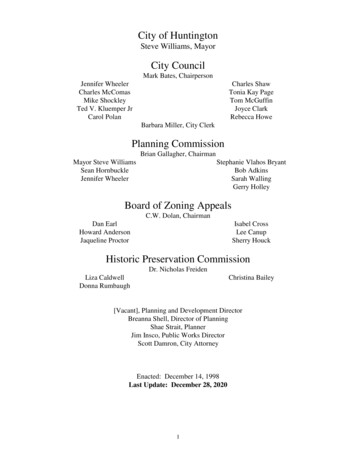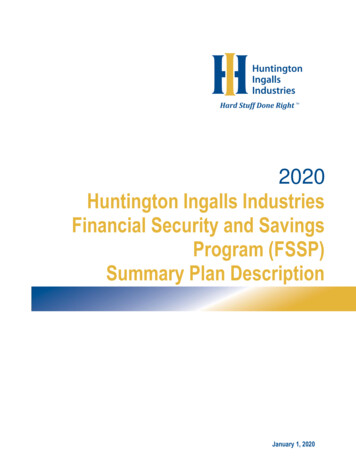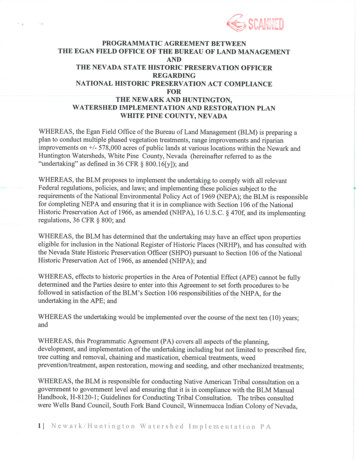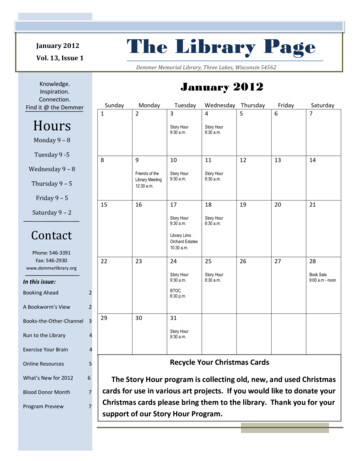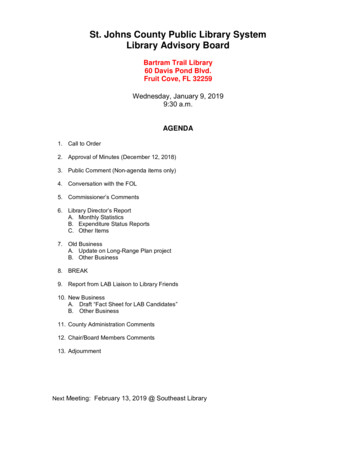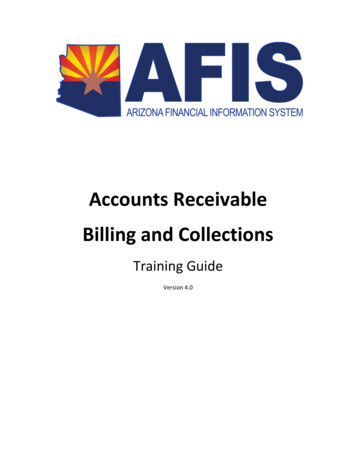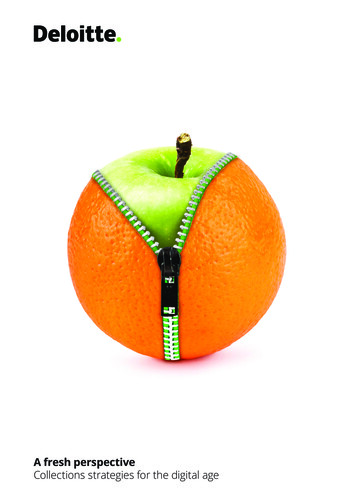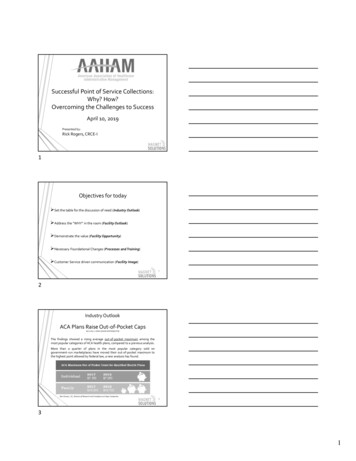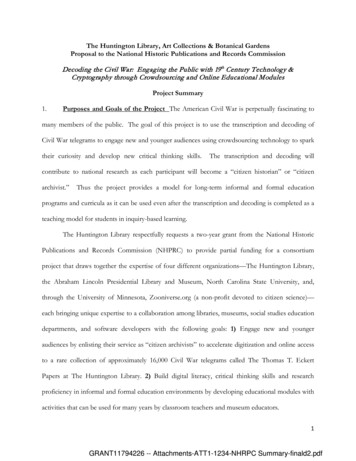
Transcription
The Huntington Library, Art Collections & Botanical GardensProposal to the National Historic Publications and Records CommissionDecoding the Civil War: Engaging the Public with 19th Century Technology &Cryptography through Crowdsourcing and Online Educational ModulesProject Summary1.Purposes and Goals of the Project The American Civil War is perpetually fascinating tomany members of the public. The goal of this project is to use the transcription and decoding ofCivil War telegrams to engage new and younger audiences using crowdsourcing technology to sparktheir curiosity and develop new critical thinking skills.The transcription and decoding willcontribute to national research as each participant will become a “citizen historian” or “citizenarchivist.”Thus the project provides a model for long-term informal and formal educationprograms and curricula as it can be used even after the transcription and decoding is completed as ateaching model for students in inquiry-based learning.The Huntington Library respectfully requests a two-year grant from the National HistoricPublications and Records Commission (NHPRC) to provide partial funding for a consortiumproject that draws together the expertise of four different organizations—The Huntington Library,the Abraham Lincoln Presidential Library and Museum, North Carolina State University, and,through the University of Minnesota, Zooniverse.org (a non-profit devoted to citizen science)—each bringing unique expertise to a collaboration among libraries, museums, social studies educationdepartments, and software developers with the following goals: 1) Engage new and youngeraudiences by enlisting their service as “citizen archivists” to accelerate digitization and online accessto a rare collection of approximately 16,000 Civil War telegrams called The Thomas T. EckertPapers at The Huntington Library. 2) Build digital literacy, critical thinking skills and researchproficiency in informal and formal education environments by developing educational modules withactivities that can be used for many years by classroom teachers and museum educators.1GRANT11794226 -- Attachments-ATT1-1234-NHRPC Summary-finald2.pdf
The purposes of the project are to 1) Provide open source access to a large, rare collection of15,922 Civil War telegrams that are owned by The Huntington Library by digitizing all the telegramsand code books; 2) Develop a crowdsourcing website with Zooniverse to utilize “citizen archivists”to decode and decipher the 15,922 telegrams with greater efficiency and accuracy than could bedone by staff at participating institutions; and 3) Design a decoding activity that is connected to CivilWar milestones and provide inquiry-based educational modules that can be used to bring historyalive to museum-goers and classroom students.This collaborative project exemplifies the goals of the NHPRC’s Literacy andEngagement with H istorical Records grant category: 1) It develops partnerships among severalinstitutions to provide educational opportunities for students and the general public; 2) The processof transcribing and decoding the telegrams builds users’ digital literacy skills and development ofeducational modules will “enhance public understanding of and access to historical records.” 3)Participants are contributing to research by transcribing and decoding the telegrams on an opensource platform (Zooniverse), where they are available to a wider audience.2.Plan of Work for the Grant Period The plan of work begins with The Huntington Librarydigitizing this rare collection of telegrams, which have, until recently, been privately held and thusnever available to the public. Concurrently, the team will begin working with Zooniverse to develop,test, and project launch the “citizen archivist” website to crowdsource the transcription processmore efficiently and quickly than could be done by The Huntington. The crowdsourcing providesthe added benefit of reaching a larger audience than can be reached by typical museums, with over400 academic, museum and library partners and over 1.3 million volunteer users. The EducationDivision of The Huntington will work with John K. Lee, a consultant with extensive experience indeveloping online education modules about Lincoln, to develop, pilot and test ten educational2GRANT11794226 -- Attachments-ATT1-1234-NHRPC Summary-finald2.pdf
modules through rigorous evaluation and then provide them through a dedicated website toteachers, museums and the general public.3. Products and /or Publications to be completed during the Grant Period Zooniverse crowdsourcing website to facilitate the efficient transcription of 16000 historictelegrams Ten teaching modules and a website to provide open source access Long-term digital preservation of the nearly 14,000 master TIFF files and accompanyingmetadata and transcriptions of the Eckert Collection of telegrams4. Names, E-Mail Address and Phone Numbers of the Project Director and Key Personnel Project Director: Mario Einaudi, the Kemble Digital Projects Librarian, The HuntingtonLibrary; meinaudi@huntington.org (626-405-2284) Project Administrator: Robin D. Gibbin, Director of Corporate, Foundation, andGovernment Relations, The Huntington Library; rgibbin@huntington.org (626 -405-3484)5.Performance Objectives—The major outcome of this project will be to engage broadaudiences, likely up to tens of thousands of “citizen historians”, with telegrams from the AmericanCivil War. In addition, through the development of the education modules and Huntington’spartnerships with the Torres High School and the Pasadena Unified School District, the educationalmodules will be integrated into teacher workshops reaching over 1000 teachers of at-risk students.Finally, these materials will be of use and openly available to scholars interested in telegraphy,cryptography, communications during wartime, technology, civilian-military relations, and manyother aspects of the Civil War or American history more generally. Perhaps the most meaningfuloutcome is that the collaborative will provide the transcription for and public access to historicalrecords that have not been seen by the public in a format that would allow them to be understoodand appreciated, and we believe will add to their understanding of the Civil War.3GRANT11794226 -- Attachments-ATT1-1234-NHRPC Summary-finald2.pdf
The Huntington Library, Art Collections & Botanical GardensProposal to the National Historic Publications and Records CommissionDecoding the Civil War: Engaging the Public with 19th Century Technology & Cryptographythrough Crowdsourcing and Online Educational ModulesProject NarrativeOver one hundred and fifty years have passed since the end of the Civil War and it stillcaptures the imagination and passion of young and old. We propose that the Civil War offers acompelling and fascinating subject with which to engage and vastly improve the public’s, and inparticular K-12 students’, relationship to history, historical records and the processes of research.1) Purposes and Goals of the ProjectThe Huntington Library respectfully requests a two-year grant from the National HistoricPublications and Records Commission (NHPRC) to provide partial funding for a consortiumproject that draws together the expertise of four different organizations—The HuntingtonLibrary, the Abraham Lincoln Presidential Library and Museum, North Carolina StateUniversity, and, through the University of Minnesota, Zooniverse.org (a non-profit devoted tocitizen science)—each bringing unique expertise to a collaboration among libraries, museums,social studies education departments, and software developers with the following goals: Engage new and younger audiences by enlisting their service as “citizen archivists” toaccelerate digitization and online access to a rare collection of approximately 16,000Civil War telegrams called The Thomas T. Eckert Papers at The Huntington Library. Build digital literacy, critical thinking skills and research proficiency in informal andformal education environments by developing educational modules with activities thatcan be used for many years by classroom teachers and museum educators.The purposes of the project are toDecoding the Civil War A Proposal to the NHPRC from the Huntington Library1GRANT11794226 -- Attachments-ATT2-1235-NHPRC proposal-finald2.pdf
Provide open source access to a large, rare collection of 15,922 Civil War telegrams thatare owned by The Huntington Library by digitizing all the telegrams and code books. Develop a crowdsourcing website with Zooniverse to utilize “citizen archivists” todecode and decipher the 15,922 telegrams with greater efficiency and accuracy thancould be done by staff at participating institutions. Design a decoding activity that is connected to Civil War milestones and provide inquirybased educational modules that can be used to bring history alive to museum-goers andclassroom students.Meeting the NHPRC’s goals for Literacy and Engagement with Historic RecordsThe major outcome of this project will be to engage broad audiences with telegrams fromthe American Civil War. Telegrams in the Civil War provided a brief, rapid form ofcommunication (a communication method that modern youth, who communicate through textmessages and tweets, may find somewhat familiar in form). Additionally, encoded telegrams areriddles that appeal to people’s desire to solve puzzles. Thus, brief, encoded telegrams from theCivil War era make a powerful combination for public engagement of citizen historians. Inaddition to a broader public, these materials will be of use to scholars interested in telegraphy,cryptography, communications during wartime, technology, civilian-military relations, and manyother aspects of the Civil War or American history more generally. Perhaps the most meaningfuloutcome is that the collaborative will provide the transcription for and public access to historicalrecords that have not been seen by the public in a format that would allow them to be understoodand appreciated, and we believe will add to their understanding of the Civil War.Thiscollaborative project exemplifies the goals of the NHPRC’s Literacy and Engagement withHistorical Records grant category:Decoding the Civil War A Proposal to the NHPRC from the Huntington Library2GRANT11794226 -- Attachments-ATT2-1235-NHPRC proposal-finald2.pdf
It develops partnerships among several institutions to provide educational opportunitiesfor students and the general public; The process of transcribing and decoding the telegrams builds users’ digital literacy skillsand development of educational modules will “enhance public understanding of andaccess to historical records.” Participants are contributing to research by transcribing and decoding the telegrams on anopen source platform (Zooniverse), where they are available to a wider audience.The Eckert Archive: Background on the Source Material for the ProjectSome historians consider the American Civil War to be the nation’s first modern war.Foreshadowing wars of the twentieth century, the participants in the American Civil War usedmodern technological devices like railroads, photography, rifled muskets and cannon, ironcladships, torpedoes, mines, submarines, aerial observation, and telegraphy. The last innovation—telegraphy—dramatically changed communications within society and war. President AbrahamLincoln avidly adopted the telegraph for communicating with Union governors in all aspects ofraising and equipping armies and for communicating with commanders in the field and receivingintelligence of the progress of battles, which revolutionized the relationship between thecommander-in-chief in Washington and generals leading armies in the field. Telegraphiccommunication allowed the President to have an impact on campaigns, and even battles, whichwas inconceivable only a few years earlier.Central to communication over electric telegraph lines was a method for reducing thealphabet and numbers into a series of distinguishable electrical impulses. Samuel Morse andAlfred Vail developed a code that reduced the alphabet into a series of dots and dashes that couldbe indented on paper tape, then reassembled by an operator into letters, words, and sentences. ByDecoding the Civil War A Proposal to the NHPRC from the Huntington Library3GRANT11794226 -- Attachments-ATT2-1235-NHPRC proposal-finald2.pdf
the time of the American Civil War, three companies had spread telegraph lines among the majorcities of the nation, and many young men had been trained in the use of the Morse Code.When the Civil War erupted in April 1861, securing lines of communication became anessential part of military efforts.Anson Stager, the superintendent of the Western UnionCompany, developed a sophisticated cipher system with which to communicate without thecontents of the messages being discovered. The War Department adopted Stager’s cipher systemand Stager became the head of the United States Military Telegraph and delegated much of theresponsibility in Washington to Major Thomas T. Eckert, who administered the War DepartmentOffice of the Military Telegraph throughout the war.Despite the importance of the United States Military Telegraph to the Union war effort,there is surprisingly little scholarship on its history. For nearly a century and a half, the Eckertfamily kept a series of ledgers and codebooks owned by Thomas T. Eckert; thisremarkable archive was purchased by TheHuntington in 2012. The archive consistsof 76 volumes dating from February 2,1862 to April 6, 1865. Together, there are15,922 telegrams, of which perhaps 5,400(34 percent) are enciphered. For detaileddescriptionsofeachvolume,seeAppendix A. Also included are fourcipher books used by Eckert, a ledger ofJay Gould's American Union Telegraph,Figure 1—Original Telegram in Abraham Lincoln's HandDecoding the Civil War A Proposal to the NHPRC from the Huntington Library4GRANT11794226 -- Attachments-ATT2-1235-NHPRC proposal-finald2.pdf
and other volumes related to the business of the Military Telegraph. See Appendix B for theFinding Aid as well as the url: finding aid for more details.Decoding Civil War Telegrams as a Model Learning ToolIn order to understand the Plan of Work, it may be helpful to the reviewer to understandthe complexity of the deciphering as is demonstrated by a letter that President Lincoln sent toGodfrey Weitzel on April 12, 1865. Figure 1 on the previous page shows the text for thetelegram and Lincoln’s instruction at the top left of the page for the text to be “cyphered.” It iswritten and signed by Abraham Lincoln. Lincoln’s telegram reads as follows:TimeOffice U.S. Military Telegraph,“Cypher”WAR DEPARTMENT,Washington, D.C., April 12, 1865.Major General WeitzelRichmond, Va.I have seen your despatch to Col Hardie about the matter of prayers. I do not remember hearingprayers spoken of while I was in Richmond; but I have no doubt you have acted in what appearedto you to be the spirit and temper manifested by me while there.Is there any sign of the rebel Legislature coming together on the understanding of my letter toyou? If there is any such sign, inform me what it is; if there is no such sign you may as closewithdraw the offer.A. Lincoln9amTinkerThe telegrapher, Charles A. Tinker wrote out Lincoln’s message on columned paper and usedCipher No. 1 to encode this message. In the Cipher, code words, or “arbitraries,” for the“President of the United States” included “Bologna” and “Bolivia.” “Emma” meant 9:00 a.m.,and “flood” meant “12” or “12th” for April 12. The telegrapher substituted key words with otherarbitraries such as “Galway” for “Richmond,” “Walnut” for “Rebel,” and “yoke” for “signature.”After the signature, the final line was filled with a brief message to complete the grid of tencolumns of eleven lines each. Next, the telegrapher also entered a copy of the encoded telegramDecoding the Civil War A Proposal to the NHPRC from the Huntington Library5GRANT11794226 -- Attachments-ATT2-1235-NHPRC proposal-finald2.pdf
in proper order in the volumes that now form a part of the Eckert Archive. The telegram is inproper order, written in columns with arbitraries in place of key words and punctuation.After writing the message in grid form, the telegrapher prepared the message fortransmission by rewriting it according to the route dictated by the selected format. Thehandwritten instructions at the beginning of the No. 1 Cipher (figure 2 & 3) explain that “Afterhaving written the message in columns commence by writing any one of the ‘Blind words’ afterthis, two of the Line Indicators taken from the same page as the route used will be used, theFigure 2—No. 1 Cipher Commencement andRoutesFigure 3—No. 1 Cipher ArbitrariesDecoding the Civil War A Proposal to the NHPRC from the Huntington Library6GRANT11794226 -- Attachments-ATT2-1235-NHPRC proposal-finald2.pdf
Figure 4—An example telegram from the Eckert Archivenumbers set indicate the no of column & route.” The Line Indicator “next” meant 2 lines, and theLine Indicator “news” meant 9 lines; added together, these words indicated an 11-line message.The telegrapher reordered the message for transmission by reading down column 6, downcolumn 10, up column 1, down column 8, up column 2, down column 4, up column 7, downcolumn 3, up column 5, and down column 9. This encryption process also added “null” words atthe end of each column to disguise the message further. The null words at the end of eachcolumn are underlined—“mean,” “your,” “never,” etc.Doing so produced the following enciphered message that could be sent by telegraph withoutdetection, as follows:Whats next news I the prayers I to while coming star what you you mean dispatch zebraI you spirit there understanding any if the piloted your offer there such of any and havewas I to Emma never seen of of no toby Zodiac on there is with what remains yoke assign my sign temper acted in to paradise flood over weitzel abe remember pekin thatmy walnut to form such why not say may it if together there you have spoken matterhave senses shelter bardie not galway in manifested torch letter in no bologne plentyDecoding the Civil War A Proposal to the NHPRC from the Huntington Library7GRANT11794226 -- Attachments-ATT2-1235-NHPRC proposal-finald2.pdf
dont sign me you legislature me appeared but bearing out unity in your prayers whiledoubt the is the is pedlar draw you downT. T. EckertIt seems little wonder, then, that the Confederates never broke this code. This telegram was thepenultimate message sent by Abraham Lincoln via telegraph, appropriately in cipher, as so manyhad been over the previous four years. The last telegram Lincoln sent was another on the sameday, also to General Weitzel in Richmond and also in cipher. Given the challenging nature ofdeciphering the Eckert Telegrams, we hypothesize that citizen archivists will become veryactively engaged in the project.2) Plan of Work for the Grant PeriodDigitizing the Collection for AccessibilityThe first step will be for The Huntington Library to digitize all of the materials and willbegin processing them in January 2015. The cost share budget shows only the portion that willbe digitized during the grant period, not the entire expenses for digitizing the entire collection.Estimating 65 pages per day, 80 percent of the digitizing will occur during the grant period and isso noted in the cost sharing portion of the budget by items. (See Appendix A: Eckert Work Planfor detailed information on image capture and long-term preservation.)Working with Zooniverse to Crowdsource the TranscriptionsBeginning in July 2015, Zooniverse will starts work with the archivist partners at TheHuntington and the Papers of Abraham Lincoln to develop the software to enable thecrowdsourced transcriptions of the telegrams on the Zooniverse website (zooniverse.org). Thedevelopment, testing, and project launch is expected to take six months and the cost is 90,000under the Zooniverse budget item. The transcription process, plus the deciphering task is quiteDecoding the Civil War A Proposal to the NHPRC from the Huntington Library8GRANT11794226 -- Attachments-ATT2-1235-NHPRC proposal-finald2.pdf
labor intensive. Thus, employing volunteer online “citizen archivists” will allow the project tobe completed in a shorter amount of time and with a much greater accuracy than would betypical for volunteers working in situ. Further, due to the online nature of crowdsourcing thesetranscriptions, this project will reach a much wider audience than typical museum volunteers.Zooniverse is an online citizen science organization founded in 2007 where projectdevelopment is overseen by a collaborative effort between Oxford University in the UK, AdlerPlanetarium in Chicago and the University of Minnesota. Zooniverse is the largest academiccrowdsourcing organization, partnering with over 400 academic, museum and library institutionsaround the world and with more than 1.3 million registered volunteers participating in over thirtyprojects in the sciences and humanities. In 2011, Zooniverse, co-led by researchers at theUniversity of Minnesota, including Dr. Fortson, began its first humanities project with “AncientLives,” in which volunteers transcribe Greek papyri fragments one character at a time using anonline keyboard. In January 2014, Zooniverse, in partnership with the Imperial War Museum(London) and National Archives (Kew) launched “Operation War Diary” to transcribe Britishunit war diaries from World War I. Volunteers have processed over 100,000 pages of text andspent more than six years of FTE effort on the project. These projects have attracted c. 8,000 and11,000 users, respectively.Drawing on seven years of crowdsourcing experience, Zooniverse will create OperationDecode to enable volunteers to transcribe and decode telegrams from the Eckert Archive.Zooniverse is currently developing a unique full text manuscript transcription model for a projectwith Tate Britain (launching mid 2015), in which multiple users will transcribe each line of textand their responses will be automatically compared using a string matrix algorithm to determineconsensus. It is estimated that Operation Decode will require five online volunteers to transcribeDecoding the Civil War A Proposal to the NHPRC from the Huntington Library9GRANT11794226 -- Attachments-ATT2-1235-NHPRC proposal-finald2.pdf
and “translate” each telegram. For each transcribed line the algorithm will compare users’transcriptions and when a predetermined subset of users has produced the same transcription thesystem will log this consensus as well as each user’s individual transcription. We anticipate thatthere will be a few instances when consensus does not emerge, in which case human editors,including project organizers and expert volunteers will be asked to arbitrate between varioususers’ transcriptions and produce a final version. The purpose of the algorithm is to minimize thedegree of editorial intervention, a bottleneck that has been identified as a major stumbling blockto producing good data efficiently in other transcription projects such as Transcribe Bentham. 1Led by Dr. Fortson, Operation Decode will build on existing Zooniverse tools, such asthe transcription platform and algorithm, but it will also build in new directions to enable thedeciphering task. The project will first ask users to transcribe telegrams, and then give them theopportunity immediately thereafter to use cyphers from the Eckert Archive and the FriedmanCollection, which will be transcribed and available in the interface at the start of the project. Themultiple transcription and algorithmic approach will ensure that high quality data is captured.When complete, the transcriptions and decoded messages will be ingested into the HuntingtonDigital Library, where they will be freely available to students, scholars, and the public.Zooniverse projects work because the Zooniverse team has a deep understanding of usermotivation one aspect of which is the ability to more fully investigate and discuss aspects of theproject. Communities of volunteers are supported through project ‘Talk’ forums where they cancomment on specific images, ask for help from fellow volunteers and experts and shareresources. Each project team is expected to and facilitated in the maintenance of blogs and othersocial media outreach, in addition to standard ‘Talk’ participation.1T. Causer and V. Wallace, “Building a volunteer community: results and findings from Transcribe Bentham”Digital Humanities Quarterly, 6 (2012).Decoding the Civil War A Proposal to the NHPRC from the Huntington Library10GRANT11794226 -- Attachments-ATT2-1235-NHPRC proposal-finald2.pdf
During the development process, the Zooniverse team will work closely with the fullproject team to determine key output data products to be delivered to Huntington Library as wellas any input metadata to accompany the telegram images that will allow citizen archivists tofollow-up with self-guided inquiry. A “beta” transcription website will provide evaluativefeedback on the site design and proper data flow from the front-end to the database. Severalhundred Zooniverse volunteers will be solicited to serve as beta testers; in addition severalstudent groups recruited through the Education aspects of the proposal will be given access to thebeta site and their feedback recorded. The full transcription project launch will be in two phases:a soft launch, in coordination with the Education team, will be targeted only towards studentsproviding the transcriptions. A full, public launch will follow with the expectation that severalthousand to tens of thousands of members of the public will participate.Developing the Educational Modules and Education WebsiteWhile the Huntington continues to digitize the telegrams and the Zooniverse develops thecrowdsourcing site for citizen archivists to move through the documents, we will begin workingwith the education specialists at North Carolina State University and The Huntington EducationDivision to develop curriculum modules that can be provided through open source teacher andmuseum educator resource sites, including the Zooniverse education site: ZooTeach.org.During this period, Interactive Designer for Education and Communications at TheHuntington, Ryan D’Orazi, and Professor of Social Studies Education John K. Lee will worktogether to develop, test and put the education modules online. The educational component ofthis project is based on the work of John K. Lee and his associates in using Lincoln telegrams toteach students to examine and analyze primary source documents. The telegrams situated in anhistorical context provide students with opportunities to build their content knowledge and toDecoding the Civil War A Proposal to the NHPRC from the Huntington Library11GRANT11794226 -- Attachments-ATT2-1235-NHPRC proposal-finald2.pdf
apply specific document analysis skills. This component will use an historical thinking scaffoldcalled SCIM-C. Lee has successfully used the SCIM-C Heuristic in his Lincoln Telegramswebsite and iPad application. The SCIM-C model includes the following components. Summarizing (Basic facts regarding the document) Contextualizing (Situating the document within its specific historical framework) Inferencing (Using the context in conjunction with the document to understand therelevance and historical events relating to the document) Monitoring (A process of self-reflection) Corroborating (Do other documents/resources confirm or challenge the initialinferences?) 2Specifically, the project will develop instructional modules for analyzing telegrams from theEckert Papers. The modules will be designed to support teachers as they work with students todeepen their knowledge of content related to the Civil War and President Abraham Lincoln’s useof the telegraph. The instructional module will include the following elements. Historical and historiographical background setting the stage for teachers’ work with thetelegrams. An inquiry plan for teachers to facilitate student investigations of compelling questionsrelated to the Eckert collection telegrams. Support materials for implementing the inquiry including connections to standards,assessment resources, and suggestions for adapting the inquiries given a variety ofteaching contexts.2David Hicks, Peter E. Doolitle, and John Lee, “History and Social Studies Teachers’ Use of Classroom and Webbased Historical Primary Sources,” Theory and Research in Social Education 32 (2004): 213-47; C. Bolick, DavidHicks, John Lee, P. Molebash, and Peter E. Doolittle, “Digital Libraries: The Catalyst to Transform TeacherEducation,” AACE Journal 12 (2004): 213-33.Decoding the Civil War A Proposal to the NHPRC from the Huntington Library12GRANT11794226 -- Attachments-ATT2-1235-NHPRC proposal-finald2.pdf
Each module will be anchored by the second element, the Inquiry Plan. These inquiries will bedesigned using the guidelines for inquiry suggested in the College, Career and Civic LifeFramework (C3 Framework). Dr. Lee was a writer for the C3 Framework and is working withnumerous states including New York (see - http://www.binghamton.edu/nys-ss/) and largeschool districts to design inquiry modules. Additionally, Dr. Lee has used this model to . These experiences will guide the development of educationalmaterials for this project.Evaluation and testing are built into the project as it progresses – not as an afterthought.The development of these modules will include input from classroom teachers and piloting inclassrooms. Ten teachers will be selected to develop the instructional modules and pilot thematerials with guidance from Dr. Lee and the historians at the Huntington Library and theAbraham Lincoln Presidential Library and Museum. Teachers wil
The Huntington Library, Art Collections & Botanical Gardens Proposal to the National Historic Publications and Records Commission . Decoding the Civil War: Engaging the Public with 19 th Century Technology & Cryptography through Crowdsourcing and Online Educational Modules

